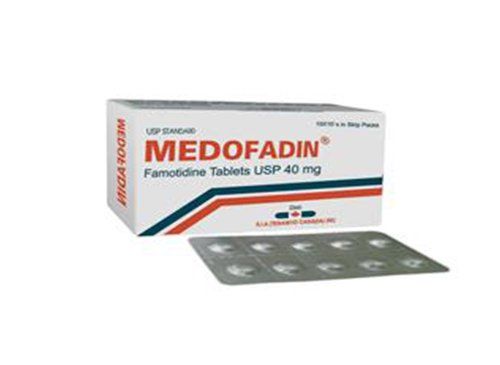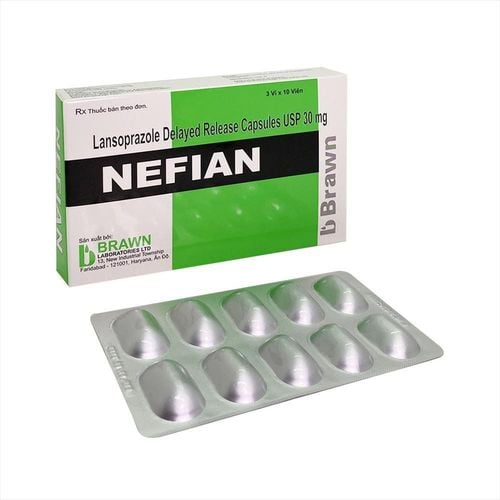This is an automatically translated article.
What does Clapra do? is the concern of many patients when they see the name of this drug appear in the prescription. Clapra is effective in the treatment of diseases of the gastrointestinal tract. The drug has the main ingredient pantoprazole sodium sesquihydrate equivalent to 40 mg pantoprazole. Read the article below to get more detailed information about this drug line.
1. What does Clapra do?
The ingredient Pantoprazol in Clapra is known to be a selective proton pump inhibitor. In terms of chemical structure, this is a derivative of benzimidazole. Pantoprazole has a selective effect on the gastric cell wall, so it acts faster and more effectively than other drugs. For cases of gastrointestinal ulcers, the healing rate of this ingredient reaches 95% in about 8 weeks of treatment. Unlike many other gastrointestinal drug classes, pantoprazole has very little effect on gastric volume, pepsin secretion, intragastric factor, and gastric contractility.When entering the body, this ingredient is quickly absorbed from the gastrointestinal tract. However, depending on the dose and gastric pH, this absorption process will change. Pantoprazole is strongly bound to plasma proteins and is highly metabolized in the liver. Pantoprazole is eliminated mainly by the kidneys with 80%. The half-life is about 30-90 minutes.
Thanks to the effects of the ingredient Pantoprazol, Clapra is indicated in the following cases:
Treatment of gastric and duodenal ulcers. Treatment of moderate to severe gastroesophageal reflux disease. Treatment of Zollinger-Ellison syndrome. Clapra can be combined with some other antibiotics to bring the effect of killing H. pylori bacteria in patients with peptic ulcer to reduce recurrence caused by this bacterium. On the other hand, this drug is contraindicated in the following cases:
Patients are sensitive to Pantoprazol ingredients or to any of the excipients of the drug. Women who are in pregnancy The patient is breast-feeding Only use the drug for children when prescribed by a doctor.
2. Dosage and usage of Clapra
Clapra is made in the form of enteric coated tablets, so patients are recommended to take it orally. The patient should drink the tablet, not allowed to crush, chew the medicine. Can be taken before or after meals. Patients should take the medicine with plenty of filtered or boiled water, not with juices or alcoholic beverages.
Dosage of the drug will be adjusted based on many factors such as: treatment purpose, patient's condition, kidney function... Patients can refer to Clapra dosage below:
Purpose of treatment inflammation, gastric ulcer: 40mg x 1 time/within 2 to 4 weeks. Gastroesophageal reflux disease: 40mg x 1 time/for 4 to 8 weeks. Treatment of Zoliger-Ellison syndrome: 4 tablets / day until the acid secretion is controlled, then reduce the dose. For patients with gastric and duodenal ulcers infected with Helicobacter Pylori, depending on the resistance pattern, there are the following schemes: 2 times a day, each time 40mg Pantoprazole + 1000mg Amoxicilline + 500mg Clarithromycin. Twice daily, each time 40mg Pantoprazole + 500mg Metronidazol + 500mg Clarithromycin. Twice daily, each time 40mg Pantoprazole + 1000mg Amoxicilline + 500mg Metronidazol. In individual cases, the dose may be doubled (2 tablets of 40 mg/day) when other treatments fail to respond. If you forget to take a dose of Clapra, take it as soon as you remember. In case it is almost time for the next dose, skip the missed dose and take the next dose as scheduled;
Overdose of Clapra can cause dangerous symptoms. Patients should proactively notify their doctor if they find themselves using more than the recommended dose.
3. Clapra . side effects
Clapra causes side effects during treatment. When these symptoms arise, it is important to notify your doctor for prompt treatment. Patients should notify their doctor for timely diagnosis and treatment instructions, and do not arbitrarily use other drugs to treat side effects of the drug.
Some side effects of Clapra have been reported such as: headache, mild diarrhea, nausea, upper abdominal pain, flatulence, skin rash, itching and dizziness... Very rare side effects occur. such as: fever, thrombophlebitis.... Common side effects tend to go away on their own after a few days or weeks. Meanwhile, serious reactions can develop and threaten the health of the user. With serious side effects, the doctor may order treatment to improve the situation.
4. Be careful when using Clapra
Some drugs can interact with Clapra such as: ketoconazole... Therefore, the patient should actively make a list of the drugs they are taking (including prescription drugs, non-prescription drugs, herbs and foods). function) and show it to your doctor or pharmacist for advice. Patients with severe liver failure should consult a doctor before using the drug. Side effects may significantly affect the ability to drive and use machines. In short, in order to ensure safety for health and maximize the effectiveness of treatment, patients need to take medication according to the doctor's instructions. Note, Clapra is a prescription drug, and patients absolutely must not use it without a prescription from a specialist.
Please dial HOTLINE for more information or register for an appointment HERE. Download MyVinmec app to make appointments faster and to manage your bookings easily.













